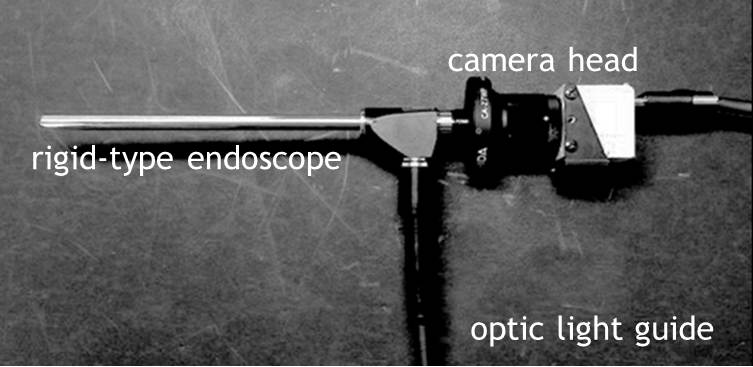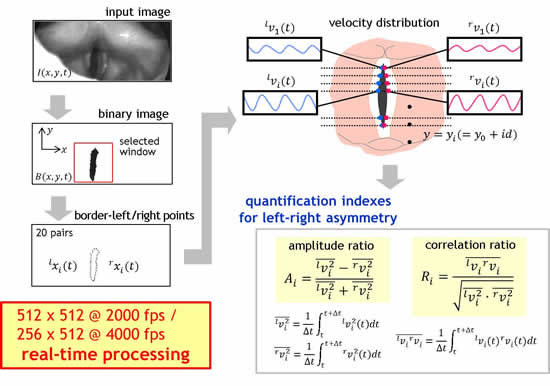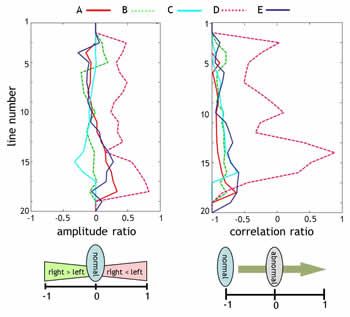RESEARCHES
Smart Vision & Robotic Sensing

Professor, Robotics Laboratory
Smart Innovation Program, Graduate School of Advanced Science and Engineering
Hiroshima University
Smart Innovation Program, Graduate School of Advanced Science and Engineering
Hiroshima University
Idaku ISHII
- >> Research Contents
- In order to establish high-speed robot senses that are much faster than human senses, we are conducting research and development of information systems and devices that can achieve real-time image processing at 1000 frames/s or greater. As well as integrated algorithms to accelerate sensor information processing, we are also studying new sensing methodologies based on vibration and flow dynamics; they are too fast for humans to sense.
Real-Time Vocal-Cord Vibration Analysis Using an HFR Laryngoscope
We have developed a high-frame-rate laryngoscope that can measure the vibration distribution of a vocal fold in real time at hundreds of hertz.
Our laryngoscope can extract a vocal-fold contour at 4000fps as 20 pairs of its left and right border points from 256×512 images to quantify left-right asymmetry of vocal-fold vibrations in real time.
 Our laryngoscope consists of an IDP Express high-speed vision platform and a rigid-type endoscope.
The camera head of the IDP Express was mounted at the end of the rigid-type laryngoscope LY-CS30 (Machida Endoscope Ltd.).
A contour-extraction algorithm was implemented for 256×512 images at 4000fps
on the IDP Express to obtain a velocity distribution as 20 pairs of border points on the left and right edges of a vocal fold in real time.
Based on the vibration velocities on the left and right edges of a vocal fold, anamplitude ratio A and correlation ratio R are introduced as quantification indexes for left-right asymmetry of vocal-fold vibrations to indicate the degree of laryngeal diseases.
Our laryngoscope consists of an IDP Express high-speed vision platform and a rigid-type endoscope.
The camera head of the IDP Express was mounted at the end of the rigid-type laryngoscope LY-CS30 (Machida Endoscope Ltd.).
A contour-extraction algorithm was implemented for 256×512 images at 4000fps
on the IDP Express to obtain a velocity distribution as 20 pairs of border points on the left and right edges of a vocal fold in real time.
Based on the vibration velocities on the left and right edges of a vocal fold, anamplitude ratio A and correlation ratio R are introduced as quantification indexes for left-right asymmetry of vocal-fold vibrations to indicate the degree of laryngeal diseases.

 We examined the vocal-fold vibrations of five human subjects under clinical conditions (512×512 images at 2000fps).
Subjects A, B, and C were healthy males in their twenties.
Subject D was a female patient in her fifties with a polypous vocal cord, and subject E was a male patient in his thirties who had had a vocal-cord noduleremoved by an operation.
For subjects A, B, and C, the amplitude ratios were around 0 and the correlation ratios were around -1.
These tendencies indicate that their vocal folds vibrated almost left-right symmetrically.
For subject D, it can be observed that the left-right symmetry in the vocal-fold vibrations was strongly disrupted because a polyp on the right side of the vocal fold disturbed vocal-fold vibrations.
For subject E, the vocal-fold vibrations were observed to be almost left-right symmetric, but the correlation ratios were slightly less than those of the healthy subjects.
This tendency corresponds to the fact that subject E felt an incompatibility in mucous-membrane movement around the site of the nodule removed from the left vocal-fold.
We examined the vocal-fold vibrations of five human subjects under clinical conditions (512×512 images at 2000fps).
Subjects A, B, and C were healthy males in their twenties.
Subject D was a female patient in her fifties with a polypous vocal cord, and subject E was a male patient in his thirties who had had a vocal-cord noduleremoved by an operation.
For subjects A, B, and C, the amplitude ratios were around 0 and the correlation ratios were around -1.
These tendencies indicate that their vocal folds vibrated almost left-right symmetrically.
For subject D, it can be observed that the left-right symmetry in the vocal-fold vibrations was strongly disrupted because a polyp on the right side of the vocal fold disturbed vocal-fold vibrations.
For subject E, the vocal-fold vibrations were observed to be almost left-right symmetric, but the correlation ratios were slightly less than those of the healthy subjects.
This tendency corresponds to the fact that subject E felt an incompatibility in mucous-membrane movement around the site of the nodule removed from the left vocal-fold.
 Our laryngoscope consists of an IDP Express high-speed vision platform and a rigid-type endoscope.
The camera head of the IDP Express was mounted at the end of the rigid-type laryngoscope LY-CS30 (Machida Endoscope Ltd.).
A contour-extraction algorithm was implemented for 256×512 images at 4000fps
on the IDP Express to obtain a velocity distribution as 20 pairs of border points on the left and right edges of a vocal fold in real time.
Based on the vibration velocities on the left and right edges of a vocal fold, anamplitude ratio A and correlation ratio R are introduced as quantification indexes for left-right asymmetry of vocal-fold vibrations to indicate the degree of laryngeal diseases.
Our laryngoscope consists of an IDP Express high-speed vision platform and a rigid-type endoscope.
The camera head of the IDP Express was mounted at the end of the rigid-type laryngoscope LY-CS30 (Machida Endoscope Ltd.).
A contour-extraction algorithm was implemented for 256×512 images at 4000fps
on the IDP Express to obtain a velocity distribution as 20 pairs of border points on the left and right edges of a vocal fold in real time.
Based on the vibration velocities on the left and right edges of a vocal fold, anamplitude ratio A and correlation ratio R are introduced as quantification indexes for left-right asymmetry of vocal-fold vibrations to indicate the degree of laryngeal diseases. 
 We examined the vocal-fold vibrations of five human subjects under clinical conditions (512×512 images at 2000fps).
Subjects A, B, and C were healthy males in their twenties.
Subject D was a female patient in her fifties with a polypous vocal cord, and subject E was a male patient in his thirties who had had a vocal-cord noduleremoved by an operation.
For subjects A, B, and C, the amplitude ratios were around 0 and the correlation ratios were around -1.
These tendencies indicate that their vocal folds vibrated almost left-right symmetrically.
For subject D, it can be observed that the left-right symmetry in the vocal-fold vibrations was strongly disrupted because a polyp on the right side of the vocal fold disturbed vocal-fold vibrations.
For subject E, the vocal-fold vibrations were observed to be almost left-right symmetric, but the correlation ratios were slightly less than those of the healthy subjects.
This tendency corresponds to the fact that subject E felt an incompatibility in mucous-membrane movement around the site of the nodule removed from the left vocal-fold.
We examined the vocal-fold vibrations of five human subjects under clinical conditions (512×512 images at 2000fps).
Subjects A, B, and C were healthy males in their twenties.
Subject D was a female patient in her fifties with a polypous vocal cord, and subject E was a male patient in his thirties who had had a vocal-cord noduleremoved by an operation.
For subjects A, B, and C, the amplitude ratios were around 0 and the correlation ratios were around -1.
These tendencies indicate that their vocal folds vibrated almost left-right symmetrically.
For subject D, it can be observed that the left-right symmetry in the vocal-fold vibrations was strongly disrupted because a polyp on the right side of the vocal fold disturbed vocal-fold vibrations.
For subject E, the vocal-fold vibrations were observed to be almost left-right symmetric, but the correlation ratios were slightly less than those of the healthy subjects.
This tendency corresponds to the fact that subject E felt an incompatibility in mucous-membrane movement around the site of the nodule removed from the left vocal-fold.  |
WMV movie(0.3M) vocal-fold vibrations (five subjects) |
